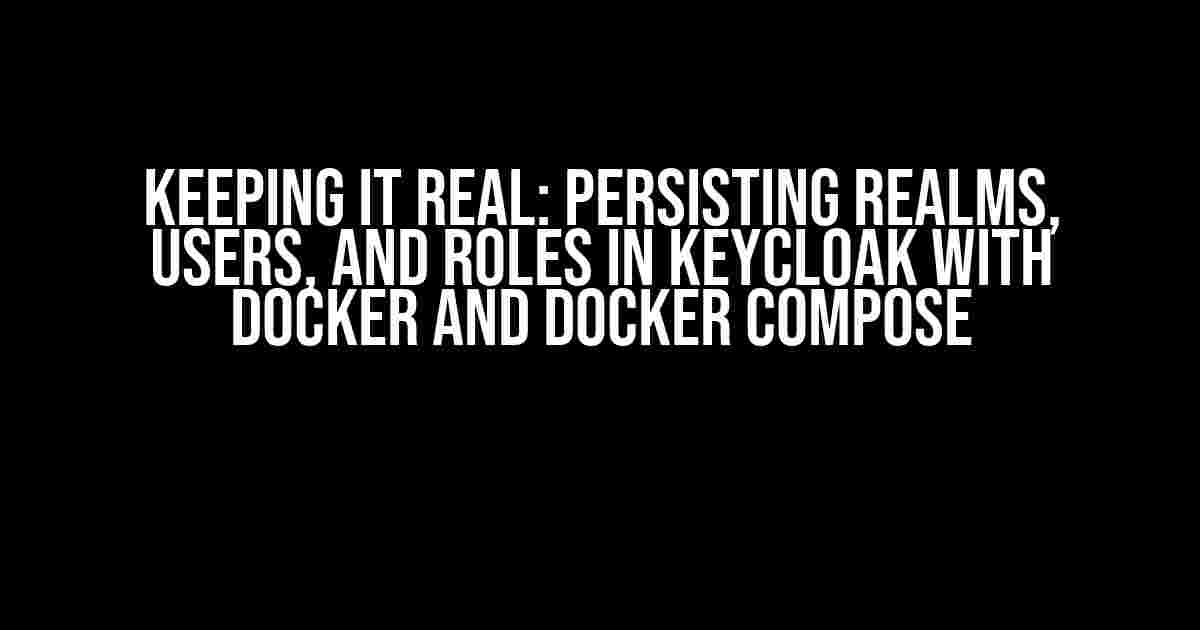Are you tired of losing your Keycloak realms, users, and roles every time you spin up a new container or restart your Docker environment? Well, fear not, dear reader! In this article, we’ll show you how to keep your Keycloak data persisted even when using Docker and Docker Compose. Buckle up and let’s dive in!
Why Persistence Matters
Keycloak is an amazing authentication and authorization tool, but it’s only as good as the data it stores. When you use Docker and Docker Compose to run Keycloak, you need to be mindful of how you persist your realms, users, and roles. Without persistence, you’ll lose all your hard work every time you restart your containers or update your Docker environment.
The Problem: Volatile Data
By default, Docker containers are stateless, meaning that any data you create inside the container is lost when the container is restarted or deleted. This is great for development and testing, but not so great for production environments where data persistence is crucial.
The Solution: Volumes and Persistent Storage
The solution to this problem lies in using Docker volumes and persistent storage. By mounting a volume to your Keycloak container, you can store your data outside of the container, ensuring that it persists even when the container is restarted or deleted.
Step-by-Step Guide to Persisting Keycloak Data
Now that we’ve covered the importance of persistence, let’s get our hands dirty and show you how to persist your Keycloak realms, users, and roles.
Step 1: Create a Docker Volume
First, let’s create a Docker volume to store our Keycloak data. Run the following command:
docker volume create keycloak-dataThis will create a new Docker volume named `keycloak-data`.
Step 2: Update Your Docker Compose File
Next, let’s update our Docker Compose file to use the `keycloak-data` volume. Here’s an example `docker-compose.yml` file:
version: '3'
services:
keycloak:
image: quay.io/keycloak/keycloak:15.0.2
environment:
- KC_DB_URL=jdbc:postgresql://postgres:5432/keycloak
- KC_DB_USERNAME=keycloak
- KC_DB_PASSWORD=password
ports:
- "8080:8080"
volumes:
- keycloak-data:/opt/keycloak/data
depends_on:
- postgres
postgres:
image: postgres
environment:
- POSTGRES_DB=keycloak
- POSTGRES_USER=keycloak
- POSTGRES_PASSWORD=password
volumes:
- postgres-data:/var/lib/postgresql/data
volumes:
keycloak-data:
driver: local
postgres-data:
driver: localNote the `volumes` section in the `keycloak` service, where we mount the `keycloak-data` volume to the `/opt/keycloak/data` directory inside the container.
Step 3: Start Your Keycloak Container
Now, let’s start our Keycloak container using Docker Compose:
docker-compose up -dThis will start your Keycloak container in detached mode.
Step 4: Verify Persistence
To verify that our persistence setup is working, let’s create a new realm, user, and role in Keycloak:
- Open a web browser and navigate to
http://localhost:8080/auth. - Log in as the admin user (default credentials are
admin/admin). - Create a new realm by clicking on the “Add Realm” button.
- Create a new user by clicking on the “Users” tab and then clicking the “Add User” button.
- Create a new role by clicking on the “Roles” tab and then clicking the “Add Role” button.
Now, let’s restart our Keycloak container to simulate a restart:
docker-compose restart keycloakOnce the container has restarted, log back into the Keycloak admin console and verify that your realm, user, and role are still present.
Troubleshooting Common Issues
While persisting your Keycloak data is relatively straightforward, there are some common issues you might encounter:
Issue 1: Data Not Persisting
If your data is not persisting, check that you’ve correctly mounted the `keycloak-data` volume to the `/opt/keycloak/data` directory inside the container.
Issue 2: Permission Errors
If you’re encountering permission errors when trying to access your Keycloak data, ensure that the `keycloak-data` volume has the correct permissions. You can do this by running the following command:
chmod 755 keycloak-dataConclusion
Persisting your Keycloak realms, users, and roles when using Docker and Docker Compose is a crucial step in ensuring data integrity and reliability. By following the steps outlined in this article, you can rest assured that your Keycloak data will persist even when your containers are restarted or deleted.
Remember, data persistence is key (pun intended) to a successful Keycloak implementation. By using Docker volumes and persistent storage, you can focus on what matters most – providing a secure and scalable authentication and authorization solution for your users.
| Key Takeaways |
|---|
| Use Docker volumes to persist Keycloak data |
Mount the volume to the /opt/keycloak/data directory inside the container |
| Verify persistence by restarting the Keycloak container and checking that data is still present |
Now, go forth and persist those realms, users, and roles like a pro!
FAQs
Q: What happens if I lose my Keycloak data?
A: If you lose your Keycloak data, you’ll need to recreate your realms, users, and roles from scratch. This can be a time-consuming process, especially if you have a large number of users and roles.
Q: Can I use a different persistence mechanism, such as a database?
A: Yes, you can use a database as a persistence mechanism for Keycloak. However, this requires additional configuration and setup. In this article, we’ve focused on using Docker volumes for simplicity and ease of use.
Q: How do I back up my Keycloak data?
A: You can back up your Keycloak data by creating a tarball of the `keycloak-data` volume. This will create a snapshot of your Keycloak data that you can restore in case of a disaster.
We hope this article has been informative and helpful in your Keycloak journey. Happy persisting!
Frequently Asked Question
Are you tired of losing your Keycloak realms, users, and roles every time you restart your Docker container? Fear not, dear developer, for we’ve got the answers to keep your Keycloak setup persistent!
How do I persist my Keycloak data when using Docker?
When running Keycloak with Docker, you need to mount a volume to persist your data. You can do this by adding a `volume` directive to your `docker-compose.yml` file, specifying the path where you want to store your data. For example: `./keycloak-data:/opt/keycloak/data` This will persist your realms, users, and roles even after you restart your container.
What if I want to keep my Keycloak configuration files separate from my Docker container?
You can use a bind mount to mount a local directory containing your Keycloak configuration files to the container. This way, you can keep your configuration files separate from your Docker container and still persist them. For example, you can add the following to your `docker-compose.yml` file: `./keycloak-conf:/opt/keycloak/conf` This will mount the `./keycloak-conf` directory on your host machine to the `/opt/keycloak/conf` directory inside the container.
How do I specify the database connection settings for Keycloak when using Docker?
You can specify the database connection settings using environment variables or a `keycloak.conf` file. For example, you can add the following environment variables to your `docker-compose.yml` file: `KC_DB_URL=jdbc:postgresql://localhost:5432/postgres KC_DB_USERNAME=postgres KC_DB_PASSWORD=postgres` Alternatively, you can create a `keycloak.conf` file with the database connection settings and mount it as a volume to the container.
What if I’m using a Docker network and want to access Keycloak from another container?
When using a Docker network, you need to make sure Keycloak is accessible from other containers. You can do this by specifying the `networks` directive in your `docker-compose.yml` file and configuring the `KC_HOSTNAME` environment variable. For example: `networks: keycloak-net environment: – KC_HOSTNAME=keycloak-http:8080` This will make Keycloak accessible from other containers on the same network.
Are there any other considerations I should keep in mind when running Keycloak with Docker?
Yes! When running Keycloak with Docker, make sure to configure the `KC_PROTECT_ERROR_DETAILS` environment variable to `true` to prevent sensitive error details from being exposed. Additionally, consider using a reverse proxy to handle SSL termination and routing, and don’t forget to regularly back up your Keycloak data to prevent data loss in case of a disaster.


